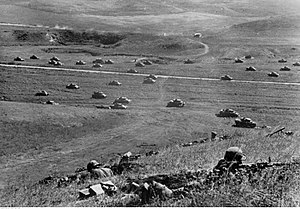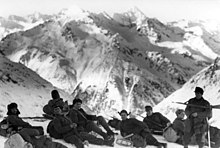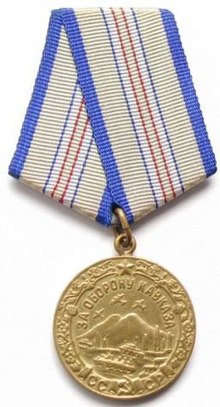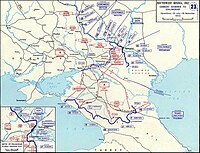Battle of the Caucasus
This article includes a list of generalreferences,butit lacks sufficient correspondinginline citations.(October 2008) |
| Battle of the Caucasus | |||||||||
|---|---|---|---|---|---|---|---|---|---|
| Part of theEastern FrontofWorld War II | |||||||||
 German tanks in formation in a Caucasus valley with infantry in the foreground, September 1942 | |||||||||
| |||||||||
| Belligerents | |||||||||
|
|
| ||||||||
| Commanders and leaders | |||||||||
|
|
| ||||||||
| Strength | |||||||||
|
July 1942: 170,000 men 1,130 tanks 4,500 guns and mortars ~1,000 aircraft January 1943: 764,000 men 700 tanks 5,290 guns and mortars 530 aircraft |
July 1942: 112,000 men 121 tanks 2,160 guns and mortars 230 aircraft January 1943: 1,000,000+ men ~1,300 tanks 11,300+ guns and mortars 900 aircraft | ||||||||
| Casualties and losses | |||||||||
| 281,000 casualties | 344,000 casualties | ||||||||
TheBattle of the Caucasuswas a series ofAxisandSovietoperations in theCaucasusas part of theEastern FrontofWorld War II.On 25 July 1942, German troops capturedRostov-on-Don,opening the Caucasus region of the southern Soviet Union to the Germans and threatening the oil fields beyond atMaikop,Grozny,and ultimatelyBaku.Two days prior,Adolf Hitlerhad issued a directive to launch an operation into the Caucasus named Operation Edelweiß. German units would reach their high water mark in the Caucasus in early November 1942, getting as far as the town ofAlagirand city ofOrdzhonikidze,some 610 km from their starting positions. Axis forces were compelled to withdraw from the area later that winter asOperation Little Saturnthreatened to cut them off.
Order of battle
[edit]Red Army
[edit]- North Caucasian Front–MarshalSemyon Budyonny(until September 1942)
- Transcaucasian Front–General of the ArmyIvan Tyulenev
- Black Sea Fleet–Vice AdmiralFilipp Oktyabrsky
- Azov Sea Flotilla–Rear AdmiralSergey Gorshkov
German Army
[edit]Army Group A–GeneralfeldmarschallWilhelm List
- 1st Panzer Army–GeneralEwald von Kleist(until 21 November 1942)
- 17th Army–GeneraloberstRichard Ruoff
- 3rd Romanian Army– GeneralPetre Dumitrescu
German operations
[edit]Operation Edelweiß, named afterthe mountain flower,was a German plan to gain control over theCaucasusand capture theoil fields of Bakuon theEastern Front of World War 2.The operation was authorised byAdolf Hitleron 23 July 1942. The main forces includedArmy Group Acommanded byWilhelm List,1st Panzer Army(Ewald von Kleist),4th Panzer Army(Colonel-GeneralHermann Hoth),17th Army(Colonel-GeneralRichard Ruoff), part of theLuftflotte 4(GeneralfeldmarschallWolfram Freiherr von Richthofen) and the3rd Romanian Army(GeneralPetre Dumitrescu). Army Group A was supported to the east byArmy Group Bcommanded byMaximilian von Weichsand by the remaining 4th Air Fleet aircraft (1,000 aircraft in all). The land forces, accompanied by 15,000 oil industry workers, included 167,000 troopers, 4,540 guns and 1,130 tanks.
Preparations
[edit]Several oil firms such as "German Oil on the Caucasus", "Ost-Öl" and "Karpaten-Öl" had been established in Germany. They were awarded an exclusive 99-year lease to exploit the Caucasian oil fields. For this purpose, a large number of pipes—which later proved useful to Soviet oil industry workers—were delivered. A special economic inspection "A", headed by Lieutenant-General Nidenfuhr was created. Bombing the oil fields was forbidden. To defend them from destruction by Soviet units under the command ofNikolai BaibakovandSemyon Budyonny,anSSguard regiment and aCossackregiment were formed. The head of theAbwehrdeveloped OperationSchamil,which called for landing in theGrozny,MalgobekandMaikopregions. They would be supported by thelocal fifth column.
Events
[edit]
After neutralizing the Soviet counter-attack in the Izyum-Barvenkovsk direction the German Army Group A rapidly attacked towards the Caucasus. WhenRostov-on-Don,nicknamed "The Gates of Caucasus," were reached on 23 July 1942 (falling on the 27th), the tank units of Ewald von Kleist moved towards theCaucasian MountainRange. The "Edelweiß" division commander,Hubert Lanz,decided to advance through the gorges of rivers of theKuban Riverbasin and by crossing the Marukhskiy Pass (Maly Zelenchuk River), Teberda, Uchkulan reach the Klukhorskiy Pass, and simultaneously through the Khotyu-tau Pass block the upper reaches of the Baksan River and the Donguz-Orun and Becho passes.
Concurrently with the outflanking maneuvers, the Caucasian Mountain Range was supposed to be crossed through such passes as Sancharo, Klukhorskiy and Marukhskiy to reachKutaisi,Zugdidi,Sukhumiand theSoviet Georgiancapital city ofTbilisi.The units of the4th German Mountain Division,manned withTyroleans,were active in this thrust. They succeeded in advancing 30 km toward Sukhumi. To attack from the Kuban region, capture the passes that led toElbrus,and cover the "Edelweiß" flank, a vanguard detachment of 150 men commanded by Captain (Hauptmann) Heinz Groth, was formed. From the Old Karachay through the Khurzukauland the Ullu-kam Gorge the detachment reached the Khotyu-tau Pass, which had not been defended by the Soviet troops. Khotyu-tau gained a new name – "The Pass of General Konrad".
The starting point of the operation on theKrasnodar-Pyatigorsk-Maikop line was reached on 10 August 1942. On 16 August, the battalion commanded by von Hirschfeld made a feint and reached the Kadar Gorge. On 21 August, troops from the1st Mountain Divisionplanted the flag of Nazi Germany on the summit ofMount Elbrus,the highest peak in both the Caucasus and Europe.
By 1 November 1942, the German23rd Panzer Divisionhad reachedAlagirand the 13th Panzer Division had reachedOrdzhonikidze,approximately 610 km from their starting positions, the high water mark of the Axis invasion of the Caucasus. The13th Panzer Divisionwas encircled by Red Army counterattacks shortly after however, but was able to break out with assistance fromSS Division Wiking.These events led Ewald von Kleist to halt further offensive operations, leading to his replacement weeks later.[1][2]
- 3 August 1942 –German ArmytakesStavropol
- 10 August 1942 – German Army takesMaykop
- 12 August 1942 – German Army takesKrasnodar
- 23 August 1942 – German Army takesMozdok
- 11 September 1942 – German Army and Romanian Army takeNovorossiysk[3]
- 1 November 1942 – German Army reaches the town ofAlagirand city ofOrdzhonikidze,North Ossetia.
Soviet operations
[edit]
1941
[edit]There were no military operations in the region in 1941. But the region was affected by warfare elsewhere in the Soviet Union.
In his memoirs, SovietTranscaucasian FrontcommanderIvan Tiulenevrecounts how thousands of civilians attempted to flee fromUkraineto the comparatively safe Caspian ports, such asMakhachkalaandBaku.[citation needed]The Caucasus area became a new area of industry when 226 factories were evacuated there during the industrial evacuations undertaken by the Soviet Union in 1941. After the Grozny toKievline was captured during Axis advances, a new link betweenMoscowandTranscaucasiawas established with the construction of the newrailway linerunning fromBakutoOrsk(viaAstrakhan), bypassing the front line atGrozny,while a shipping line was maintained over theCaspian Seathrough the town ofKrasnovodskinTurkmenistan.
1942
[edit]In 1942, theGerman Armylaunched Operation Edelweiß which was aimed at advancing to theoil fields of Azerbaijan.The German offensive slowed as it entered the mountains in the southern Caucasus and did not reach all of its 1942 objectives. After the Soviet breakthroughs in the region aroundStalingrad,the German forces in the Caucasus were put on the defensive.
Soviet military operations included
- Tikhoretsk-Stavropol Defensive Operation(25 July – 5 August 1942)
- Armavir-Maikop Defensive Operation(6–17 August 1942)
- Novorossiysk Defensive Operation(19 August – 26 September 1942)
- Mozdok-Malgobek Defensive Operation(1–28 September 1942)
- Tuapse Defensive Operation(25 September – 20 December 1942)
- Nalchik-Ordzhonikidze Defensive Operation(25 October – 12 November 1942)
1943
[edit]

In early 1943, the Germans began to withdraw and consolidate their positions in the region due to setbacks elsewhere. They established a defensive line (Kuban bridgehead) in theTaman Peninsulafrom which they hoped to eventually launch new operations in the Caucasus. The fighting remained reasonably static until September 1943 when the Germans ordered fresh withdrawals which effectively ended the period of fighting in the Caucasus.
Soviet Operations in 1943 consisted of the following.
North Caucasus Strategic Offensive (Operation Don)
- Salsk-Rostov Offensive(1 January – 4 February 1943)
- Mozdok-Stavropol Offensive(1 January – 24 January 1943)
- Novorossiysk-Maikop Offensive(11 January – 4 February 1943)
- Tikhoretsk-Eisk Offensive(24 January – 4 February 1943)
- Rostov Offensive (5–18 February 1943)
- Krasnodar Offensive (9 February – 24 May 1943)
- Novorossiysk-Taman Operation(10 September – 9 October 1943)
The key military base ofNovorossiyskwas retaken in September, 1943.
- 3 January 1943 –Red ArmyretakesMozdok
- 21 January 1943 – Red Army retakesStavropol
- 23 January 1943 – Red Army retakesArmavir
- 29 January 1943 – Red Army retakesMaykop
- 4 February 1943 – Soviet marines repel a German attempt to land atMalaya Zemlya,an island fort that controlled access to the port atNovorossiysk.Soviets hold this island until relieved in September, denying the use of the port to the Germans.
- 12 February 1943 – Red Army retakesKrasnodar
- 16 February 1943 – Red Army retakesRostov
- 9 September 1943 – the Germans begin to retreat from theBlue Linedefensive positions
- 16 September 1943 – Red Army occupiesNovorossiysk,relieving the sailors and marines atMalaya Zemlya.
- 9 October 1943 – Red Army controls the whole of theTaman Peninsula
1944
[edit]During theWinter Spring Campaign of 1944(1 January – 31 May), the Soviet army was able to launch aninvasion of the Crimeafrom the Caucasus, which was fully recaptured by 12 May 1944.
Operations included:
- Kerch-Eltigen Amphibious Offensive Operation(31 October 1943 – 11 December 1944)
- Perekop–Sevastopol Offensive(8 April – 12 May 1944)
- Kerch–Sevastopol Offensive(11 April – 12 May 1944)
Anti-Soviet insurgency (1940–1944)
[edit]See also
[edit]References
[edit]- Alexander Werth,The Battle of Stalingrad,Chapter 7, "Caucasus, there and back", pp. 648–651
- Ivan Tyulenev,"Cherez Tri Voyny" (Through Three Wars), Moscow, 1960, p. 176.
- ^Neidel, Indiana (6 November 2021)."167 – The Allies Break Through! – WW2 – November 6, 1942".Timeghost History.Retrieved17 April2024.
- ^Neidel, Indiana (13 November 2021)."168 – Axis and Allies Both Invade France – WW2 – November 13, 1942".Timeghost History.Retrieved17 April2024.
- ^Robert Forczyk,The Caucasus 1942–43: Kleist's race for oil
Bibliography
[edit]- (in Russian)Иван Тюленев.Крах операции "Эдельвейс".Орджоникидзе, 1975.
- (in Russian)К.-М. Алиев.В зоне "Эдельвейса".М.-Ставрополь, 2005.
- Javrishvili K.Battle of Caucasus: Case for Georgian Alpinists,Translated by Michael P. Willis, 2017.
External links
[edit]- (in Russian)Ясен Дьяченко. История альпинизма. Война на Кавказе
- (in Russian)Великая Война – Кавказ
- (in Russian)Операция "Эдельвейс". Последняя тайна
- (in Russian)Товарищи под знаком Эдельвейса / Kameraden unterm Edelweiß
- Battles of World War II involving Romania
- Conflicts in 1941
- Conflicts in 1942
- Conflicts in 1943
- Conflicts in 1944
- Battles and operations of the Soviet–German War
- World War II aerial operations and battles of the Eastern Front
- Battles of World War II involving Germany
- Mountain warfare
- History of the Caucasus under the Soviet Union
- Azerbaijan in World War II
- Chechen–Russian conflict


